Help With Electrical Fundamentals
Everything that gets done in nature gets done because of the action of a force. There are four fundamental forces responsible for everything you see happening around you, including the functioning of the human body. Gravity is one of these forces, perhaps the one most familiar to you. Another, the one we concern ourselves with here, is the electrical force. (The other two are the strong and weak nuclear forces, which are outside the range of human experience, so I won't mention them.)
In the brain, electrical force rules! To understand how the brain works, we must have some basic understanding of that statement, and to begin with we will examine why electrical force exists at all.
First let me give you some links. For an excellent review in more detail than I will go into here of basic electrical principles, these websites are very good. I tell you about them because, if I confuse you, it might help you to go to one of these sites, and also because I "borrowed" some of the images I'm using from these excellent sites.
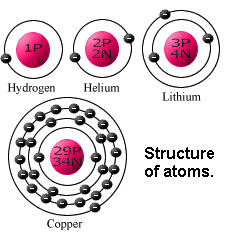
Without getting into an argument with physicists about the ultimate structure of matter, we will go with the grade school explanation that matter is comprised of three kinds of fundamental particles: protons, neutrons, and electrons. Two of these particles are electrically charged, and all this means is that they respond to the electric force. Protons carry a positive charge, and electrons carry a negative charge. Neutrons are uncharged or neutral, which means the electric force does not affect them. Protons and neutrons are found in the core or nucleus of the atom, while electrons are found in orbits around the nucleus. Since the neutrons play no role in how atoms respond to electrical force, we shall henceforth ignore them completely. The electric force does, so why shouldn't we?
The atoms shown in the diagram are electrically neutral, as is most matter,
because there are equal numbers of protons and electrons, and the positive charges
on the protons exactly cancel out the negative charges on the electrons. However,
sometimes atoms lose an electron or gain an electron. When this happens, they
become electrically charged and are called ions.
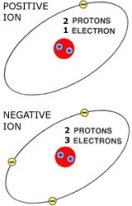

loss or gain of electrons ------------------------->
Ionization, the process of ion formation, often occurs when atoms or
molecules are dissolved in water. And since the human body, including the brain,
is mostly water, this is a process that should interest us very much. Table salt,
for example, is comprised of one sodium (Na) and one chlorine (Cl) atom per
molecule. When you put NaCl in water, the molecule comes apart, but the sodium
atoms lose an electron, and the chlorine atoms gain one, thus becoming sodium
ions (Na+) and chloride ions (Cl−). Hydrochloric acid (HCl) does the same,
dissolving into hydrogen ions (H+) and chloride ions (Cl−).
In the brain there are five ions we are going to deal with at some point during the course. They are:
- sodium ions (Na+) - important in forming action potentials (electrical impulses) in neurons
- potassium ions (K+) - also important in forming action potentials
- chloride ions (Cl−) - they play a more subtle role to be discussed a little later in the course
- calcium ions (Ca++) - which we won't hear about until later
- organic anions (A−) - big molecules like proteins that have gained electrons to become negatively charged
The most fundamental law of electric force is this: unlike charges attract,
and like charges repel.

Bodies (or atoms or molecules -- ions) with like charges will separate themselves if they are free to move. Unlike charged bodies must be forced apart or held apart by an insulator or they will move back together again. When electrically charged particles move, this is called an electric current. Important point: In grade school you were probably taught that electric current is due to the movement of electrons. This is true in wires and metal conductors. However, ANY movement of electric charges, including ions, constitutes an electric current. Thus, sodium ions moving across a cell membrane constitutes an electric current.
Thus, electric currents are just the movement of charged particles, and the particles move because they either attract or repel one another. If unlike charges are separated, they want to move back together again. If there is a path for them to move along, called a circuit (closed circuit to be precise), the charges will move until everything is neutralized again and there is no more charge separation. In a neuron, for example, the inside of the cell is negatively charged relative to outside. Outside the cell there is a high concentration of positively charged sodium ions. Thus, if they were able to, those ions would move to the inside of the cell, creating an electric currrent of moving sodium ions.

Now imagine this, and I don't think this will strain your imagination too very much. You've just had a lot of beer. And I mean, a whole lot of beer! Before long... well, you know. Unfortunately, there is no place to go, and so you just have to hold it. The longer you hold it, the more urgent the need becomes to relieve yourself. Before too much longer, you're in dire straits, but there just isn't any place to go, not even a handy bush. Eventually, um, there's an accident.
Something similar happens with electricity. Speaking anthropomorphically,
when unlike charges are separated (drinking beer), they feel a certain urgency
to reunite. The urgency they feel depends upon how much charge has been
separated and how far apart the charges are (time since drinking).
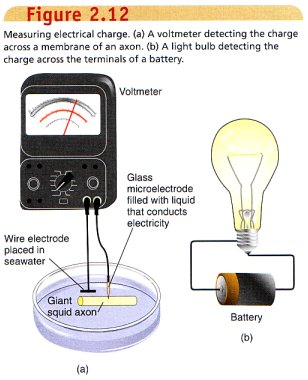
Voltage is a measure of the pressure unlike charges feel to reunite. In the image at right (from the textbook--although the figure number has changed in this edition), voltage is being detected across the poles of a battery by using a small lightbulb. The lightbulb glows because a voltage between the poles forces electrons through the filament of the bulb, thus heating it. If you take a more sensitive voltmeter and stick one of the electrodes inside an axon while leaving the other outside in the seawater bath, a voltage will be measured. This tells you, without any doubt, that there is a separation of electric charge across the membrane of the axon. That is the only thing that can create a voltage. Axons, and entire neurons as it turns out, are electrically polarized. That is, using a sensitive enough measuring device, a voltage can be measured across the membrane of the cell. The inside of the cell has more negative charges than the outside, which is more positive, and that creates a voltage across the cell membrane. A voltage is also called an electric potential. When the cell is at rest, the voltage that can be measured across the membrane is called the resting potential. This voltage causes ions with a positive charge to "want" to move into the cell and ions with a negative charge to "want" to move out of the cell. (Roughly speaking. As we'll see, there is more to it than that.) If a path exists along which they can move, then they will move, thus generating an electric current across the membrane.
There is more to "urgency" than voltage, however. Have you ever noticed how, when ya really gotta pee, the closer you are to being able to relieve yourself, the more urgent the need to do so? There you are! You've found a bathroom AT LAST, and it's like you can't get your clothes open fast enough! The need becomes almost overwhelming. A similar thing happens in electricity. The urgency that charged particles feel to come back together depends not only upon pressure (voltage), which is determined by how much charge has been separated, but also upon how far apart the charges are. The closer together they are, the more urgency they feel. (Kinda like being away from your girlfriend of boyfried for awhile, to use another analogy that may be more immediate to you at the moment.)
Thus, the urgency charges feel to rush to each other is best expressed by
combining the voltage measure with a measure of distance between them. The
result is called electric field strength.
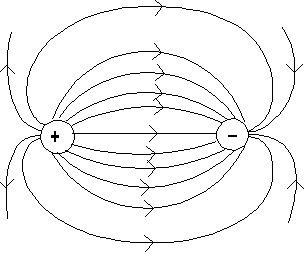
An electric field exists between unlike charges any time they are separated.
You can think of it as the "pull" between them. The strength of this pull is
the strength of the electric field:
Let's take a look at an electrical storm as an example.
In an electrical storm, negative charge builds up in a cloud base and
positive charge builds up in the ground. The cloud and the ground are quite
far apart, so a lot of charge is needed before anything happens. Add to this
the fact that air is a decent insulator, and there you go. We need a whopping
lot of voltage. But the charges keep building and building and the pull between
them becomes stronger and stronger (the field strength continues to build up)
until finally the cloud wets its pants. Ah...
I mean, it lets go with a lightning bolt. A lightning bolt is just a whole lot
of electric current flowing between the cloud and the ground reuniting the
unlike charges that have been separated. How strong does the electric field have
to be to get a lightning bolt? (There is a point to this calculation, so bear
with me a minute.)
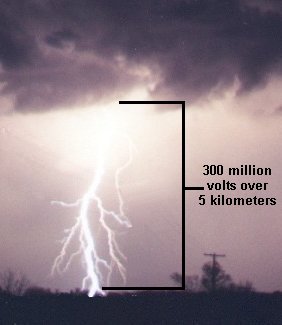
A potential difference (voltage) of 300,000,000 volts over a distance of
5,000 meters (5 km) is often enough to cause the insulating properties of the
air to break down, allowing a lightning bolt to be generated. Thus:
= 60,000 volts / meter
The field strength needed to generate a lightning bolt is about 60,000 volts per meter. And a lightning bolt is pretty dramatic stuff. There are few phenomena in nature more impressive. (Don't memorize these figures for crying out loud!)
Consider this. The voltage across an axon membrane when the axon is at rest
is about 70 millivolts (70 thousandths of a volt or 0.07 volts). That sounds
pretty piddly compared to the figures we were just dealing with, but the distance
across the membrane is only 7 nanometers (7 billionths of a meter or 0.000000007
meters). Do the math. The strength of the electric field across an axon's
membrane is 10 million (10,000,000) volts per meter. Who has to pee more
urgently, the thunder cloud, or the axon? The axon's "need to pee" ("felt
urgency") is around 150 times MORE than that of a thunder cloud! The only
thing that holds it back is the insulating properties of the membrane. Remember,
the cell membrane is composed of fat molecules, and fat is a very good insulator.
It has to be, because that axon really really really urgently wants "to go." If
we can just open a channel for those charges to flow through, we're going to get
something, on a small scale, that is even more dramatic than a lightning bolt!
We're going to get an action potential.
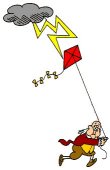
A few more details need to be considered, which brings us to Ben Franklin. You remember Ben, the guy who went out and flew a kite in a thunderstorm, and was lucky he wasn't fried to a crisp for doing so! He's famous as one of the early statesmen of the American Colonies and early United States, but at the time he was even more famous as a scientist looking into the nature of electricity. He was especially interested in electric current, and he knew (to use the language of today) that it was the result of charged particles moving through a conductor. But which way do the particles move? That was the big question of the day, and one that wasn't solvable with 18th century technology. So Ben made something up. (It really didn't matter as far as the math was concerned -- all it changed was a sign.) Ben said electric current flows from positive to negative. Electricians have been peeved at him ever since.
Because when the conductor is a metal, like the wiring in a house, and the
charged particle that is moving is an electron, then the electron moves from
negative to positive. In a wire (or any metal conductor) current in the form of
moving electrons moves from negative to positive. Bummer! Well, not so. We
neurophysiologists are quite grateful to Ben, because in the brain, in axons,
the charge carriers that are most significant are sodium ions and potassium
ions, and they carry a positive charge. So they move from positive to negative,
just like ol' Ben said. Way ta go, Ben!

True for wires
but not for
neurons!
Neurons have an excess of negative charges inside the cell membrane. These exist for the most part in large, negatively charged, organic ions. These organic molecules are too large to move through the channels that are going to open in the membrane, so they are going nowhere. Outside the cell membrane there is an excess of positive charges, mostly in the form of excess sodium ions. These are small enough to move through the channels. And the urgency with which they want to move, as we've seen, is phenomenal! When those channels open, the sodium ions are going in and thus creating an electric current through the cell membrane that is even more dramatic, on the small scale of a neuron at least, than a lightning bolt in an electrical storm.
What you don't know yet, but soon will, are three things:
- How did the neuron get to be electrically polarized to begin with?
- What are those channels and what causes them to open?
- What closes the channels again?
- AND (okay, four things) if the neuron does this often enough, why doesn't it run down and lose its ability to function?
Here's another figure from the textbook you might want to stare at for awhile.
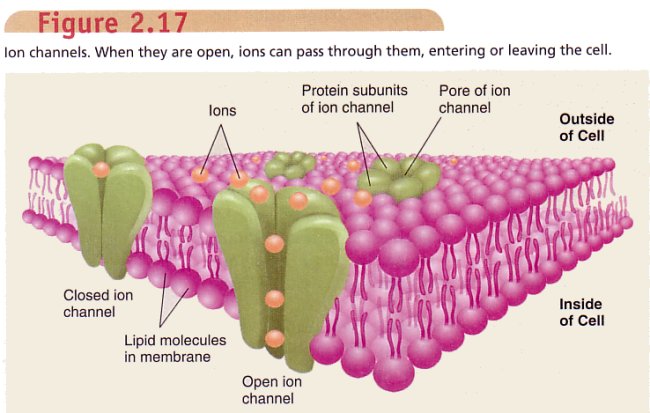
It shows a neuron membrane. The purple molecules are lipid (fat) molecules, and fat is an excellent insulator. Thus, it prevents the positive charges outside the cell from reuniting with the negative charges inside the cell. Embedded in this membrane, however, are large protein molecules, which make up ion channels (green). These channels are often closed, and thus no ions can move through them. But occasionally they open (we will learn why later), and then ions flow through them very rapidly, creating an electric current through the channel. This is the beginning of the action potential. So the action potential is: 1) created by ions moving across the cell membrane through ion channels, 2) which is caused by a pre-existing voltage difference across the membrane, the resting potential.
Return to PSYC 460 Main Page